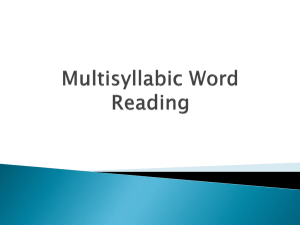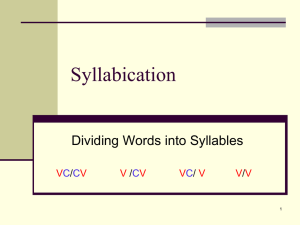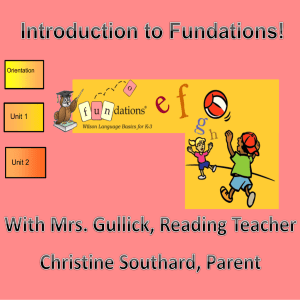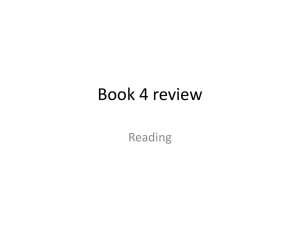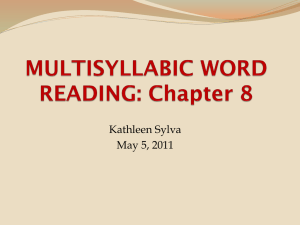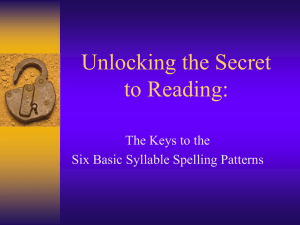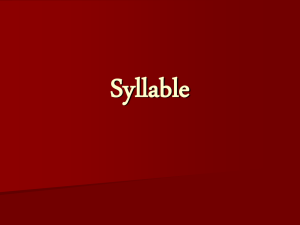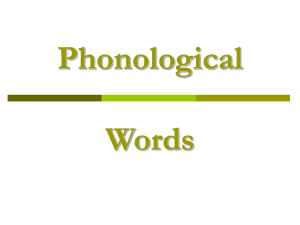MULTISYLLABIC WORD READING
advertisement
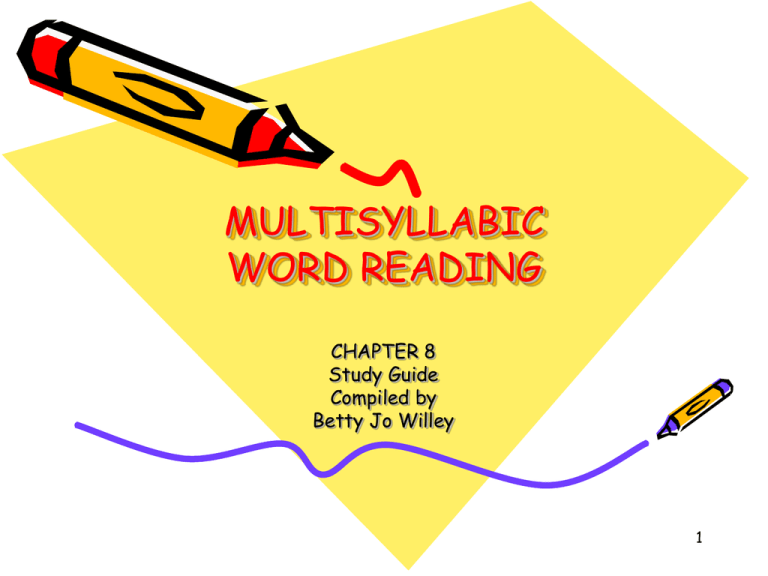
MULTISYLLABIC
WORD READING
CHAPTER 8
Study Guide
Compiled by
Betty Jo Willey
1
WHAT! Introduction to Chapter 8
• Multisyllabic Word Reading
Explicit Instruction in recognizing syllables and
morphemes is essential because it gives students additional
strategies for reading longer words.
~Important Because
*Students often have difficulty with
multisyllabic words.
*5
graders and beyond must know how to decode
because most of the words they encounter will have
7 or more letters and have 2 or more syllables.
th
2
Brain Function =
Pattern Detection
“To read words in text fluently and accurately, the
brain’s “orthographic” processor must learn to “see”
common letter patterns and recurring word parts.” (p. 260)
Pattern detection is key to recognizing
syllables and morphemes.
3
Chunk it !
• Don’t understand a big word?
• Brain Function = Pattern Detection
Skilled Readers must be able to:
Recognize multi-letter patterns (syllables, affixes, phonograms)
Chunk it (break into smaller pieces) into parts as the reader
perceives the word.
Use knowledge of common patterns found in other words.
4
Practice is Best…Intro Continued…
a.
Key Definitions:
Syllable – A word or part of a word pronounced as a unit
Unit – part of a word with one vowel sound; may see more than
one vowel per unit/syllable – but always hear only one
vowel sound
Syllabication – division of multisyllabic word into
separate syllables
b. What research says ~ Rules:
To Know or Not To Know
Past Decades
=
Memorize rigid rules
NOW what researchers say
about RULES….
----too many
----too complex
----knowing them doesn’t
necessarily improve
students’ decoding skills
***Students learn they can be flexible in dividing a word into parts as long as they can
ultimately make the word into a real and recognizable word.
(Archer et. Al. 2003, 2006)
5
More Intro….How to Teach Students to Decode Longer
Multisyllabic Words:
3 Research-based Approaches
1
2
3
Use syllable
types and
division
principles
Identifying
affixes or
word parts
Using flexible
syllabication
strategies
***These approaches differ in
how the words are broken down
into decodable units…
6
In this Guide…
Section A Section B Section C Section D
WHAT
WHY
WHEN
HOW
I.
Syllables
a. what they are
b. research says
II.
Affixes
a. what they are
b. research says
I.
Important to
know because:
II.
Research says
I.
When to
Teach
II.
When to
Assess
Good Teaching
Explained
I.
II.
III.
When to
Intervene
Reading Open &
Closed Syllables
Reading
Multisyllabic
Words (1-7)
1. VC/VC
2. VCV
3. Syllable
Segmentation
Strategy
4. Syllabic Procedure
5. Introducing Affixes
6. Flexible Strategy for
reading big
words
7.Root word
Transformation
*these are not outlined in
detail … refer to
pp.272 - 318.
7
SECTION A
WHAT
8
Section A.
WHAT?...Part I. Syllables
a. What they are
(review from slide 5)
Syllable – A word or part of a word pronounced as a unit
Unit – part of a word with one vowel sound; may see more
than
one vowel per unit/syllable – but always hear only one
vowel sound
Syllabication – division of multisyllabic word into
separate syllables
6 Common Types of syllables
(in sequence for syllable-type instruction)
1.
2.
3.
Closed
Vowel Consonant e
Open
4. Vowel Combination
5. Consonant – le
6. r - controlled
(See p. 62 in text to study complete description & examples)
9
Syllable Types and (most
useful)
Division Principles
VC/CV
C/CV (75%)
VC/V (25%)
VC/CCV
VCC/CV
2 consonants
between 2 vowels
1 consonant
between 2 vowels
3 consonants
between 2 vowels
If 2 consonants come
between 2 vowels,
divide the consonants.
The 1st vowel will be
short.
If a word has 1
consonant between 2
vowels, divide the word
after the first vowel
and give the vowel the
long sound. If this
division does not
produce a recognizable
word then divide the
word after the
consonant and give the
vowel a short sound
Keep the letters in a
consonant blend or
digraph together in the
same syllable.
rab-bit
mu-sic nap-kin
hun-dred
ink-well
ath-lete
Consonant
- le
Consonant – le
forms a separate
syllable
If the first syllable end
with a consonant, try
the short sound of the
first vowel. If the first
syllable ends with a
vowel, try the long
sound.
wig-gle
ri-fle
10
b. What some researchers say…
about Syllable Types
Webster regularized these syllable
types to justify the division of
syllables in his 1806 dictionary.
Henry: Students should first
practice the identification of syllable
Types in single syllable words before
Identifying the syllables in
multisyllabic words.
Moats: Knowledge of syllable types
will help students remember how to
pronounce vowels in new words.
Shefelbine & Newman called open and
closed syllables the basic building
blocks of polysyllabic words.
Sheflbine, Lipscomb & Hern found significant relationship
between students’ sight knowledge of open & closed
syllables and students’ ability to read multisyllabic words.
11
….and what some researchers say
about division principles
Carreker familiarity and flexibilty
with syllable-division principles help
students to develop strategies for
reading longer words.
Canney & Schreiner Most
syllable-division principles, rules
and generalizations are not
reliable and thus not worth
teaching.
Chall & Popp “ The best way we teach
and learn syllabication of long words
is to be playful, correcting errors
with cheer and laughing easily at
humorous misleadings.
Moats These ([most useful] principles
help novice readers see the chunks or
patterns of letters in multisyllabic
words and guide correct
pronunciation.
Chall & Popp, Blevins …useful/reliable principles…worth
pointing out…they do get readers closer to identifying a
multisyllabic word by providing a way to approximate the
pronunciation.
12
About dictionary-based
syllabication rules
• Use caution when looking up syllable breaks
in a dictionary.
– Most dictionaries divide words according to how a
printed word should be broken into text
– Sometimes has little to do with spoken pronunciation
– (Moats 2005) Spoken language (reading?) divisions
often do not coincide with the conventions for dividing
written syllables.
– Adams et al. What is important is that each unit is
pronounceable (sounding out … sim-ple or simp le)
13
4 other syllable division rules
(worth mentioning..)
Divide 2 syllable compound words between the two smaller words.
Inflectional endings such as –ing, –er, –es, –ed, -est often form
separate syllables.
Never separate the letters in a consonant or vowel digraph, vowel
diphthong, or r-controlled vowel across syllable divisions.
One of the syllables in a multisyllabic word usually receives more
stress, or emphasis. In 2 syllable words, the stress usually falls on
the first syllable. In the unstressed syllable, the vowel sound is
often reduced to a schwa.
14
Section A.
WHAT?… Part II. Affixes.
a. What they are?
~Prefixes (added before a root word)
~Suffixes (added after a root word)
Definition:
~ Root word – also called base word; a single word that cannot
be broken into meaningful smaller words or parts
Note: Syllable divisions often occur between morphemic
(meaningful) units of meaning (word parts).
15
What researchers say
about AFFIXES
Venezky, Chomsky, McFeely Teach
students to use root words and affixes to
decode multisyllabic words.
Note: Most divisions occur between
morphemic units of meaning/word parts.
Cunningham said “instant recognition
and accurate pronunciation of affixes
is the key to decoding long words”
(Note: 80% of all words readers
encounter have 1 or more affix.
Carnine et al. Part-by-word part
strategy…should begin with the
introduction of the most common suffixes.
-s, -er, -est, -ing, -le, -ed, -y
Shefelbine & Newman Affixes that
function like syllables are worth
teaching because they are limited in
number, occur frequently, and
(mostly suffixes) are reasonably
consistent across words.
Archer et al. Engelmann et al. Part by part
strategy is when students are taught
pronunciation of affix in isolation, asked to
identify and say it in a word the n read the
whole word
Archer et al. assumption: students will
develop a strategy for attacking
multisyllabic words because of extensive
practice in reading long words and
exposure to recurring letter patterns
16
So…rather than using rigid rules…
teach students to be
F LEX IBLE (p. 267)
Segmenting multisyllabic words
Accuracy when students form consolidated connections between spellings of
letter units or syllables
Break words into spoken syllables
Match spoken syllable to their spellings
Blend segments to form recognizable word
(Bhattacharya & Ehri, 2004)
Based on information that
1. high percentage of multisyllabic words contain at least one
prefix or
or suffix
2. each syllable contains one vowel sound
Archer et. Al (2006)
TO ACHIEVE a close approximation to the actual pronunciation of a
word, the program teaches students to segment words into parts
by identifying the AFFIXES and then the vowel sounds in the
rest of the word.
17
SECTION B
WHY
18
Section B.
WHY?… Part I. Importance
Important to know about multisyllabic words
because:
From 5th grade on, the average student encounters about 10,000 new words, most
multisyllabic, per year!
Since the meaning of intermediate-grade CONTENT AREA reading is generally
carried by multisyllabic words, without the ability to decode multisyllabic words,
students are unable to understand vocabulary and understand the meaning of what
they read.
19
Section B.
WHY?… Part II.
Research says…
Good readers = accurate multisyllabic word analysis and recognition
Poor readers = inaccurate multisyllabic word analysis and recognition…
which happens because the reader processes the individual
letters in the word rather that breaking the word into syllables….
(Bhattacharya, 2006, Mewhort and Beal, 1977, Scheerer-Neumann 1981)
Several studies have shown that teaching students strategies for decoding longer words improves their
decoding skill (Archer et al.)
Low decoders
o
correctly pronounce fewer affixes and vowel sounds
o
disregard large portions of letter information
o
2 to 4 times more likely to omit syllables
(Shefelbine & Calhoun, 1991)
So…teaching strategies for decoding improves decoding ability and {improves reading?}
20
SECTION C
WHEN
21
Section C.
Part I. When... To teach:
Instruction in multisyllabic instruction
can begin
after
students have mastered
the decoding of
Single-syllable words.
Other Prerequisites include the
Ave # of syllables increases steadily
in the primary grades.
abilities to:
1. pronounce common sound/spelling Students are (by the end of)
1st grade – reading mostly
correspondences
1 & 2 syllable
---especially vowel combinations
words
2. identify open and closed syllables
2nd grade – reading mostly
3. pronounce affixes in isolation
2 syllable words
3rd grade – reading longer
multisyllabic words
22
Section C.
Part I. When... To teach:
Older Struggling Students
(middle – high school students)
Mastered basic decoding but lack strategies to decode
multisyllabic words
Struggle with content area words that are outside their
vocabulary
Ironically – current research does not indentify/specify the
amount of explicit instruction necessary for struggling
students after third grade.
23
Section C.
Part II. When… To Assess:
Begin assessment in multisyllabic word reading in mid-second
grade in order to plan effective intervention.
Assessment should determine whether the
deficit can be attributed to a bigger
problem…
24
Section C.
Part III. When...To Intervene
Assess mid-second grade in order to plan
Effective intervention…
“It is not clear form current research the amount of
explicit multisyllabic word instruction necessary for
struggling readers after third grade” (Torgesen et al.
2007).
Early Intervention!!!!
25
SECTION D
HOW
(Good Teaching Ideas Outlined )
26
Section D.
Parts I & II
HOW…To Teach
IDEAS TO USE
IN THE CLASSROOM
SEE CHPT 8 pp. 272-318
1. Assess (pretest)
2. Introduce
3. Teach/Model
4. Guided Practice (monitor)
5. Application (independent practice)
27
THE END
Chapter 8
Study Guide
28

